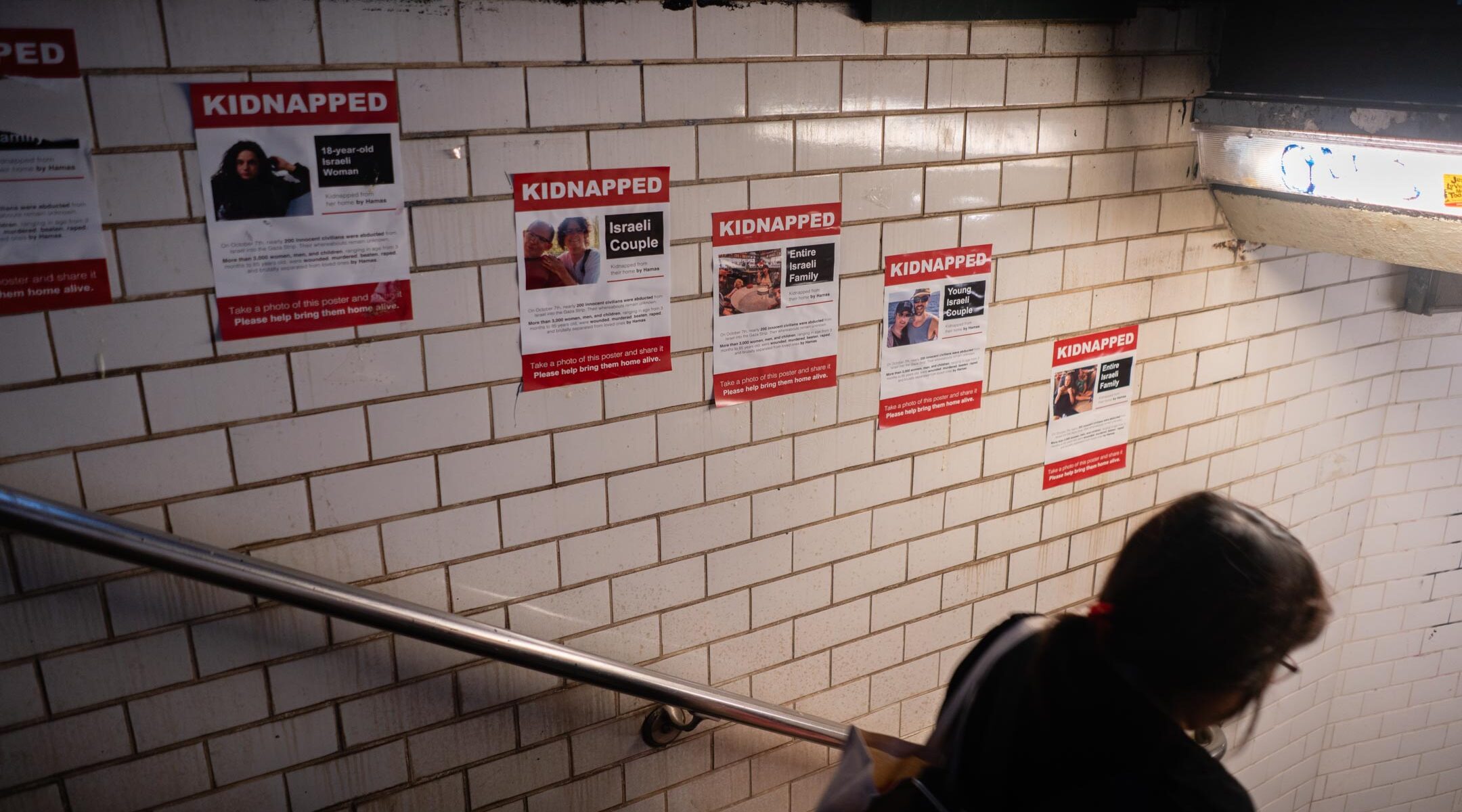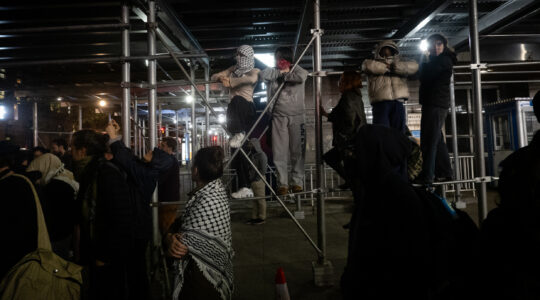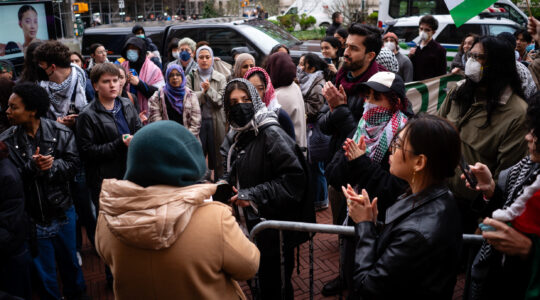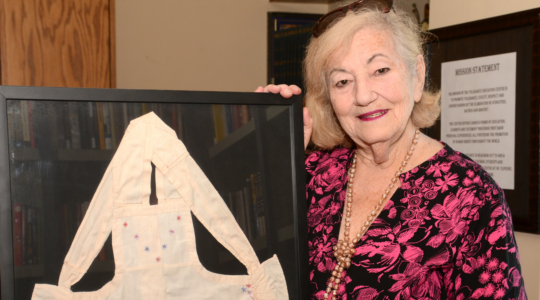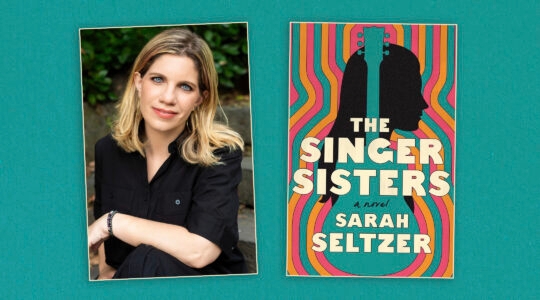(New York Jewish Week) — The hundreds of flyers lining the walls of the Union Square subway station bore the faces of Israeli hostages, with the word “kidnapped” in bold letters above the photo and a plea to bring them home below.
“Entire Israeli family,” one of the pages said; “80-year-old Israeli grandfather,” read another. Others showed the faces of teenagers, a young couple or migrant workers, all missing and believed to be held by Hamas in Gaza.
But some of the posters were also hard to make out. Within minutes or hours of going up, many of them had been partially ripped off the subway station’s walls, tears obscuring the victims’ faces or details about their lives, while others were defaced with marker or surrounded by messages such as “Free Palestine.” Others were removed because of city regulations.
This week, the walls of New York City’s subway stations, campus buildings and other public spaces — along with those of other cities across the globe — have been plastered with the posters, a grassroots campaign to raise awareness of the roughly 200 hostages Hamas captured in its Oct. 7 attack on Israel. The fast-spreading initiative has given an outlet to supporters of Israel abroad who feel frustrated by their inability to aid the war effort, and isolated by their distance from the fighting.
But the posters have also become one more front in the battle for public opinion on the war — with opponents of Israel tearing down the posters, berating the activists and launching a counter-campaign highlighting Palestinian losses.
“We wanted to put the message out there. We wanted the world to know,” said one of the creators of the “Kidnapped From Israel” project, an Israeli street artist who goes by the nom de plume Dede Bandaid. “Every place they will tear them down, we will put up many, many more.”
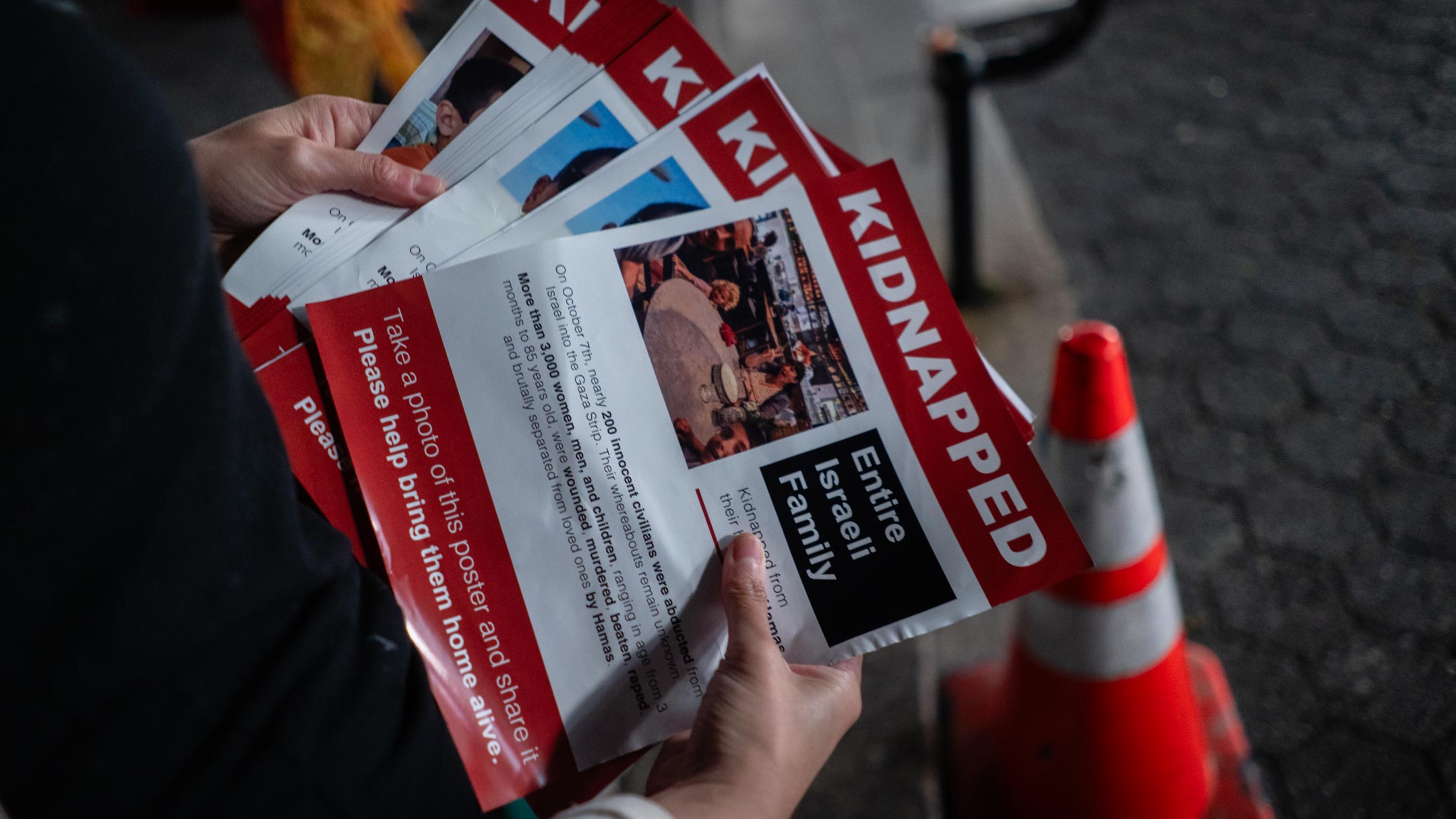
An Israeli activist prepares to put up posters near New York City’s Union Square subway station, October 16, 2023. (Luke Tress)
Bandaid and his partner, Israeli artist Nitzan Mintz, were in New York on a three-month art residency when the war broke out. Within a day of Hamas’ attack, they decided to put their skills as street artists to use by designing and printing out the flyers. Initially, they printed 2,000 posters, taped them up around the city, and tried to enlist the help of passersby, most of whom dismissed the project.
“We felt that people don’t want to know the stories and it made us very sad,” Bandaid said. “We got home and we were very broken and we thought, ‘There’s no chance to make this project work.’”
They then posted a DropBox folder with the fliers on social media and collapsed into sleep. “When we woke up in the morning, our phones were just filled with photos and videos from people sharing what they were doing,” Bandaid said. “The whole city was filled with posters.”
The project spread online, overwhelming their DropBox capacity, so they set up a website where anyone could download the images, and began receiving requests for translations from abroad. There are now posters in more than a dozen languages, including Greek, Romanian, Finnish and Indonesian, and campaigners dispersing the posters in far-flung locations such as Paris, New Zealand and Prague. Bandaid estimates that around 1,000 activists took up the initiative in Berlin.
Celebrities including Gal Gadot have gotten on board, posting the images on social media, while other campaigners have adapted the flyers and projected them onto the sides of buildings, put them on billboards or on digital truck displays in New York City and elsewhere. WhatsApp groups created earlier this year by Israeli expatriates to coordinate protests against Israel’s judicial overhaul now feature callouts to put up the posters.
“I feel like for me to start with this campaign, I needed that, not just for my own people but also for myself to feel to be part of a community,” said Israel artist Ronit Levin Delgado, who connected with Mintz through mutual friends in the art world. “For me as an Israeli, with all my family in Israel, that’s the only thing I can do right now because I cannot be there.”
Support the New York Jewish Week
Our nonprofit newsroom depends on readers like you. Make a donation now to support independent Jewish journalism in New York.
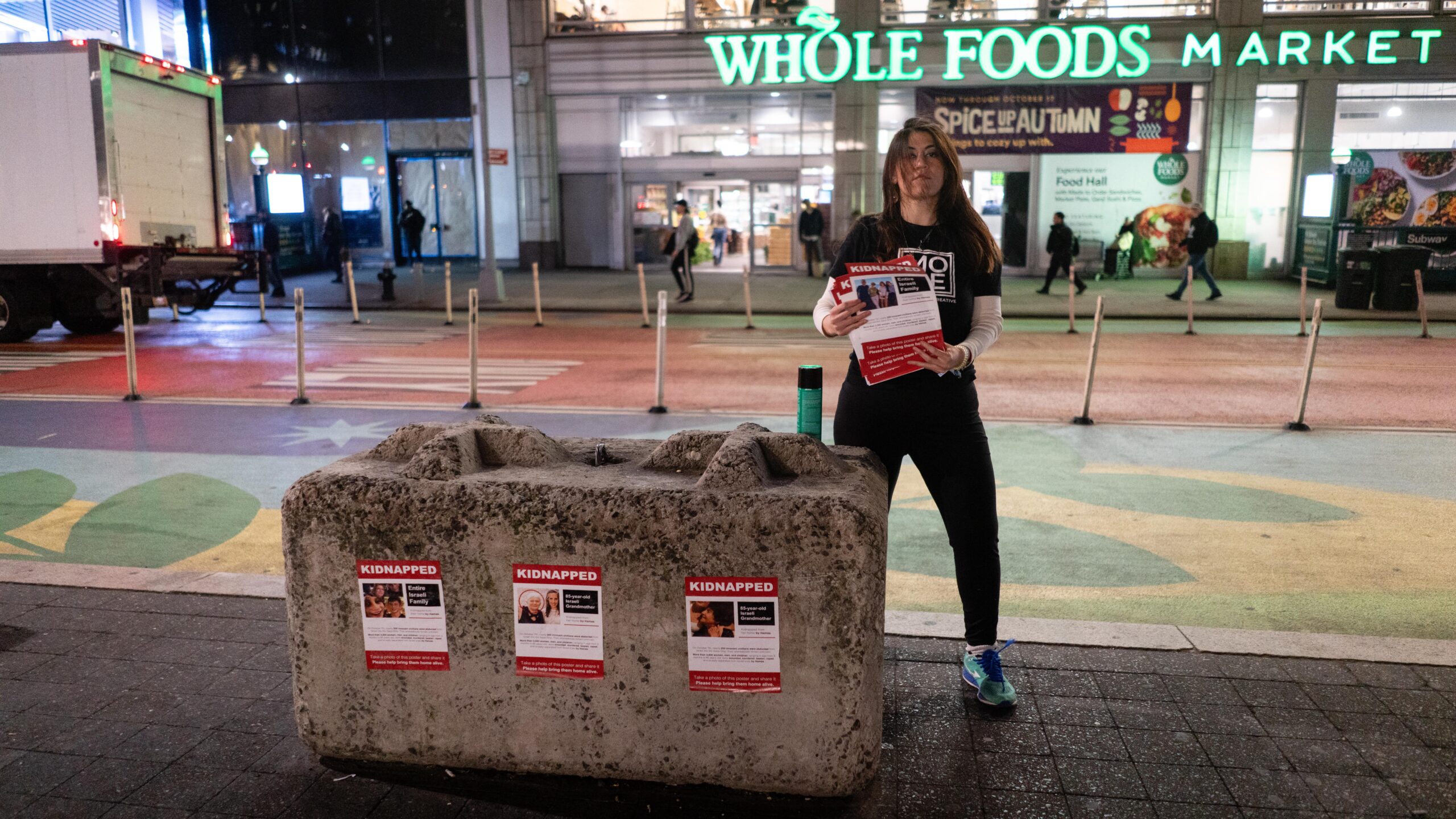
Israeli artist Ronit Levin Delgado in New York City’s Union Square, October 16, 2023. (Luke Tress)
To obtain consent to use the photos, Bandaid and Mintz work with a designer in Israel, Tal Huber, who contacts the families of the hostages to obtain their pictures and identifying details. Around 100 of the 200 hostages are featured on the flyers. Some of the families have reached out to the artists, asking that their loved ones be included in the campaign. Others, after receiving notice that their loved ones were killed, have asked that their photos be removed.
“The idea of being kidnapped, the idea of wanting someone to have his freedom, I think it’s a very strong message and I think many people believe in that,” Bandaid said. “We just lit the match, but everyone took it to their own end.”
Levin Delgado, who lost a friend from the artist community in the massacre of 260 people at an outdoor party, assembled with several dozen other activists, mostly Israelis, at Union Square to post the images in and around the subway station on Monday night. She said the group put up 2,000 posters in four hours, and part of their goal was to interact with passersby, some of whom stopped to ask about the project.
One young woman stopped on her way down to the station platform to ask Levin Delgado about the flyers. “They’re taking everyone, no mercy for anyone. Women, children,” Levin Delgado told her. “We just want to raise awareness and bring them back.”
The woman appeared sympathetic. “I heard about what’s going on, but I wasn’t sure specifically. I didn’t know about the hostages,” she said. “I’ll definitely share it. I’ll take a picture.”
But almost as soon as they went up — in some cases, within minutes — many of the posters were torn down, leaving glue marks and tattered paper on the station walls.
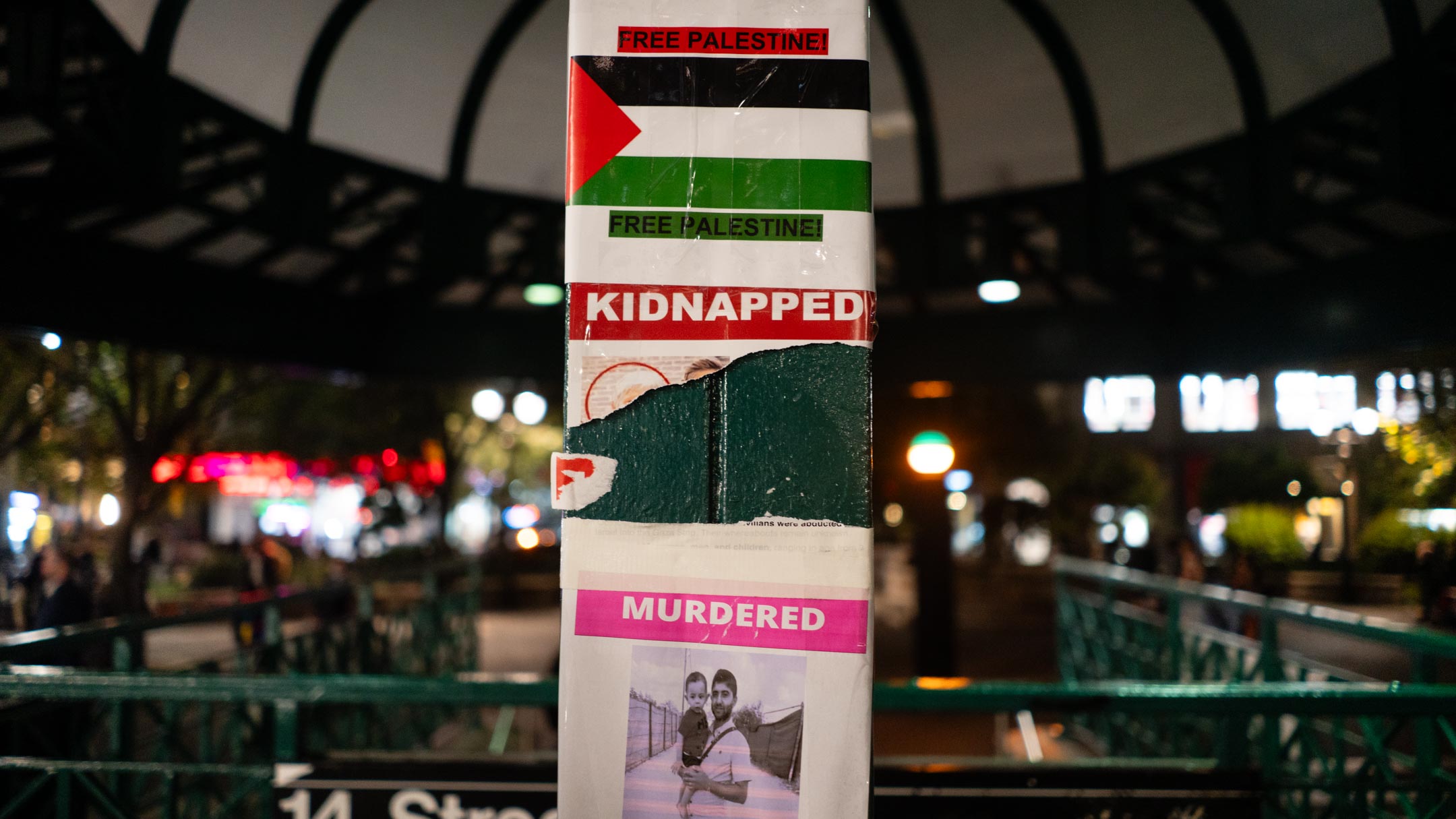
A torn poster about Israeli hostages surrounded by pro-Palestinian messages in New York City’s Union Square, October 16, 2023. (Luke Tress)
Levin Delgado noticed pro-Palestinian activists pasting messages around hostage flyers posted outside the station. The pro-Palestinian posters featured the Palestinian flag, or a photo of a Palestinian captioned with the words “Murdered” and “Stop the oppression.” The posters appeared to be an imitation of the Israeli fliers.
In some cases, someone had written “Free Palestine” in black marker on the Israeli hostage posters. Other fliers bore the image of a Palestinian-American boy killed in Illinois on Monday.
Levin Delgado confronted the pro-Palestinian activists, concerned they were removing the Israeli posters, and got into a heated exchange about the conflict.
“We have almost 2,000 that got murdered,” Levin Delgado said.
“We have millions over the last many years,” one of the pro-Palestinian activists said, a significant exaggeration of the Palestinian death toll throughout the history of the conflict. The pro-Palestinian activists declined to be interviewed by the New York Jewish Week.
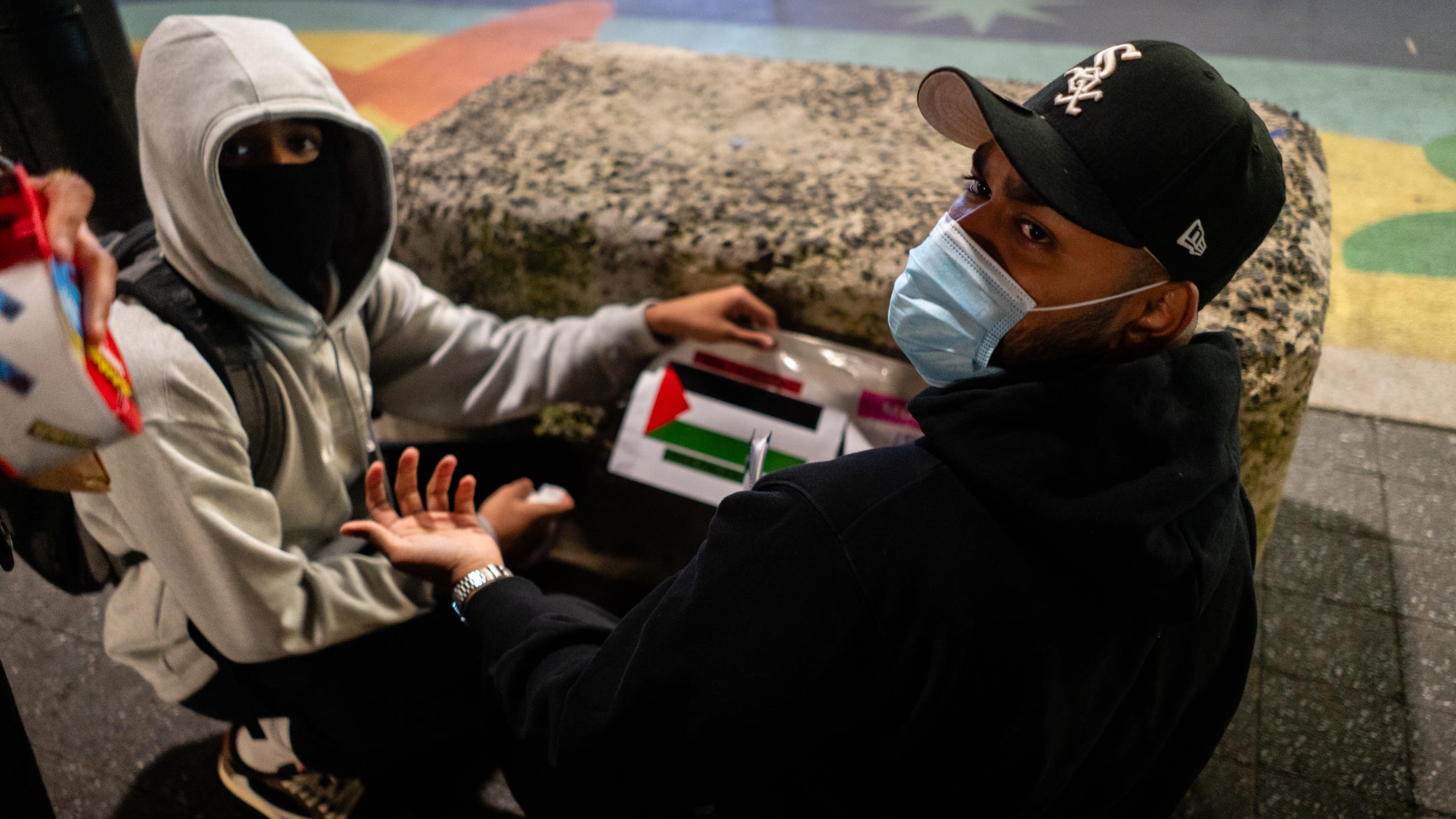
Pro-Palestinian activists put up posters near New York City’s Union Square subway station, October 16, 2023. (Luke Tress)
Tensions stayed high, but the two sides finally agreed to leave each other’s posters alone. The verbal sparring continued, however, and minutes later, another passerby tore another Israeli hostage poster down and threatened to punch Levin Delgado when she addressed the incident.
Support the New York Jewish Week
Our nonprofit newsroom depends on readers like you. Make a donation now to support independent Jewish journalism in New York.
Not all posters were removed for ideological reasons. Some came off subway station walls due to Metropolitan Transportation Authority policy, which bars putting unauthorized signs up on MTA property. An MTA spokesperson said staff remove any posters they see while making their rounds, and added that the fliers were allowed elsewhere. Activists have posted them on street light poles, walls and other public spaces.
Union Square isn’t the only place where the posters have sparked debate. At New York University, just blocks away, the campus group Students Supporting Israel posted photos online of the posters being thrown in the trash, and of people holding bunches of the crumpled, torn posters in their arms.
Ari Axelrod, an American Jewish actor, director and singer, said police had politely removed some of the fliers he helped put up at Columbus Circle on Monday. Axelrod had been leaving the roundabout’s subway station when he came across a group of Israelis and offered to join them. A pro-Palestinian activist then barged into the group and started tearing down the flyers, Axelrod said.
“This guy just comes up and says, ‘Put up all the faces of the Palestinian hostages of the past 75 years,’” Axelrod said. “He kept talking, saying, ‘You’re supporting genocide. You’re supporting ethnic cleansing.’”
The pro-Palestinian activist left the scene to summon police, who told the Israelis that the signs were not allowed on MTA property. One of the Israelis, who had put up the posters, asked that only police or MTA officers remove the flyers so they would not be “desecrated” by others.
“The cops were very understanding. ‘We get why you’re doing it, we understand, but it has to come down,’” Axelrod said, quoting the police. “The police said, ‘We’ll stand guard, we’ll leave it up for a little bit and make sure nobody else takes it down.’”
Axelrod said he watched the police as they surveyed the posters, reading the names and looking at the pictures.
“One of the police officers says, ‘Four years old. Jesus,’” before he started removing the posters, Axelrod said.
The group of Israelis headed back up to the sidewalk, where the person who had directed the effort to hang the posters broke down in tears.
Back downtown, after clashing with rival activists, some of the Israelis kept hanging the posters. Levin Delgado, still toting a bag of flyers and glue, made a last lap around Union Square to check how many remained on the wall. At a staircase down to the subway, she was elated to find a row of posters nearly intact, but then noticed two freshly-drawn swastikas on the opposite white tile wall. She sprayed the hate symbols with glue and pasted an image of a kidnapped Israeli family on top.
